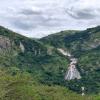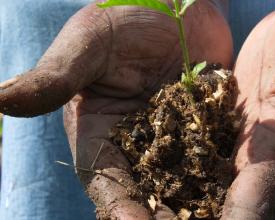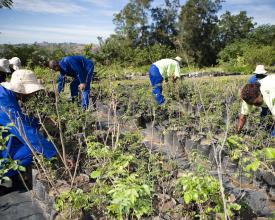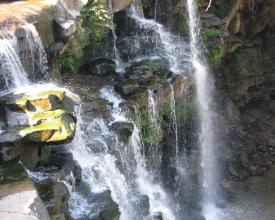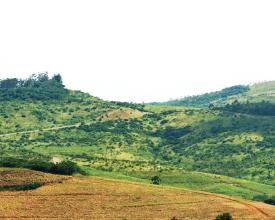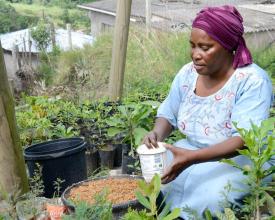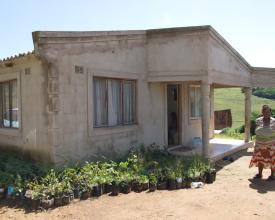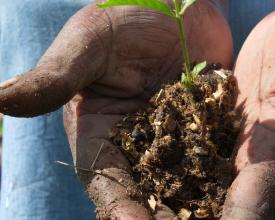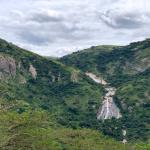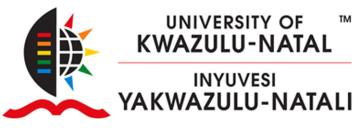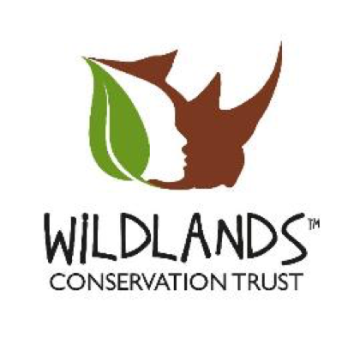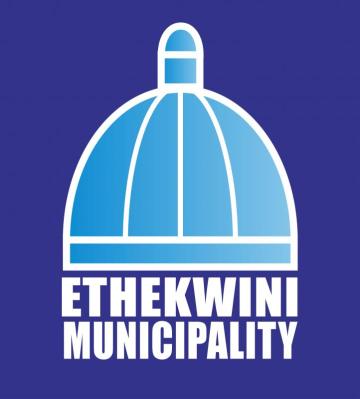
Adaptación basada en los ecosistemas en Durban (Sudáfrica): el proyecto de reforestación comunitaria de Buffelsdraai
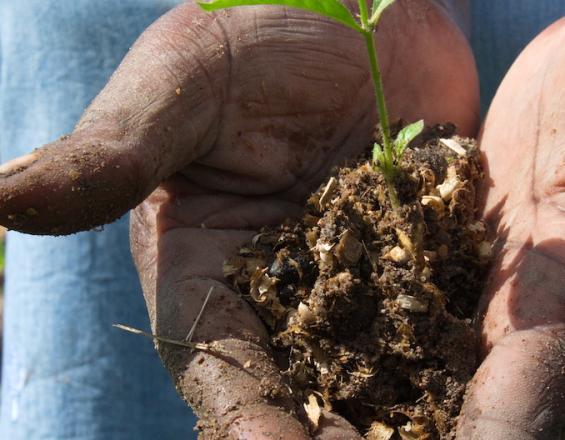
El proyecto de reforestación comunitaria del vertedero de Buffelsdraai, ejecutado por el municipio de eThekwini (área metropolitana de Durban), es un proyecto emblemático que demuestra numerosos beneficios colaterales de adaptación y mitigación. El proyecto ha tenido un gran éxito a la hora de mostrar el papel que desempeñan los ecosistemas naturales a la hora de asegurar los medios de vida y la resiliencia de las personas, y el papel que pueden desempeñar las comunidades humanas a la hora de apoyar, restaurar y proteger los ecosistemas locales.
Contexto
Défis à relever
Se prevé que los riesgos climáticos, como las lluvias torrenciales con gran capacidad erosiva, el aumento de las temperaturas medias anuales y las olas de calor, y las sequías más frecuentes, repercutan negativamente en los ciudadanos y la biodiversidad de la zona metropolitana de Durban. Entre las amenazas concretas figuran la escasez de agua, la inseguridad alimentaria, las inundaciones, la propagación de enfermedades como la malaria y el cólera, y los daños a las infraestructuras.
"La ciudad sudafricana de Durban es un ejemplo típico de las muchas ciudades pequeñas y medianas de todo el mundo que pueden verse gravemente afectadas por el cambio climático. Estas ciudades se encuentran atrapadas en una "tormenta perfecta" de crecimiento demográfico, aumento de las necesidades de adaptación y déficits de desarrollo sustanciales creados por la escasez de recursos humanos y financieros, el aumento de los niveles de informalidad, la mala gobernanza, la degradación del medio ambiente, la pérdida de biodiversidad, la pobreza y la creciente desigualdad (Roberts, D. & O'Donoghue, S. 2013)".
Ubicación
Procesar
Resumen del proceso
BB 1: Dar forma a la naturaleza - La restauración de los ecosistemas forestales es el núcleo de la solución. El modelo Tree-Preneuer y el centro de reforestación añaden una perspectiva socioeconómica a largo plazo. BB 1 y BB 2 son elementos importantes de un proceso de cambio concreto con mejoras tangibles y beneficios de resiliencia para las comunidades locales y la biodiversidad. Este prometedor enfoque ha allanado el camino para el desarrollo de un concepto de adaptación comunitaria basada en los ecosistemas (ACBE) (BB 3), cuyos principios están ahora integrados en una serie de proyectos, como parte de un objetivo estratégico de integración institucional.
Bloques de construcción
Dar forma a la naturaleza - Restauración de los ecosistemas forestales
Además de su conceptualización original como proyecto de mitigación, elProyecto de Reforestación Comunitaria del Vertedero de Buffelsdraai aporta varios beneficios importantes para la adaptación, garantizando la mejora del suministro de un gran número de otros servicios ecosistémicos (por ejemplo, calidad del agua, atenuación de inundaciones, regulación de sedimentos, regulación del caudal de los ríos). Todos estos servicios ecosistémicos mejoran aún más la capacidad de adaptación de las comunidades locales y reducen el impacto de los riesgos climáticos a corto y largo plazo, como las lluvias torrenciales con gran capacidad erosiva, las inundaciones y la erosión sobre los residentes locales y las infraestructuras grises. Así, se demuestra el fuerte y vital vínculo que existe entre los ecosistemas naturales y las comunidades humanas a las que sustentan y protegen, y entre las comunidades humanas que sustentan, restauran y protegen los ecosistemas locales.
Factores facilitadores
- Apoyo al proyecto por parte de los líderes locales y compromiso de los miembros de la comunidad.
- Comprensión de los objetivos y beneficios del proyecto por parte de las comunidades vecinas.
- Asociación entre el Departamento de Planificación Medioambiental y Protección del Clima (EPCPD) y el Departamento de Residuos Sólidos de Durban (DSW).
- Financiación inicial del Gobierno danés y cofinanciación del Fondo Verde Nacional.
Lección aprendida
- El proyecto ha demostrado que la restauración forestal puede aportar beneficios socioeconómicos directos a las comunidades circundantes mediante la mejora del funcionamiento del ecosistema.
- Sin embargo, es necesario seguir examinando y evaluando los beneficios del proyecto. Por ejemplo, todavía no se ha medido ni se conoce el alcance de los beneficios ecológicos y de los servicios ecosistémicos, como la mejora de la calidad del agua, la regulación del caudal de los ríos, la mitigación de las inundaciones, el control de los sedimentos, el atractivo visual y la reducción del riesgo de incendios.
Forjar el futuro - El modelo Tree-preneuer, la investigación in situ y el centro de reforestación
El municipio de EThekwini adoptó un enfoque innovador de restauración forestal denominado "Árboles autóctonos para la vida", desarrollado y promovido por Wildlands Conservation Trust. El concepto implica la formación de empresarios del árbol en las comunidades beneficiarias. Los facilitadores enseñan a los empresarios a cultivar y cuidar plantones de árboles autóctonos en "viveros domésticos" hasta que alcanzan una altura adecuada. La formación inicial se imparte en la zona de la comunidad y garantiza la transferencia de conocimientos sobre dónde recoger las semillas y cómo cultivarlas. El apoyo y la tutoría continúan durante todo el proyecto. Los árboles se intercambian por notas de crédito, que pueden utilizarse para comprar alimentos, bicicletas, materiales de construcción o para pagar la matrícula escolar o las clases de conducción de vehículos. Además, un enfoque de "medios de vida sostenibles " pretende desarrollar la generación de medios de vida mediante la formación de empresarios comunitarios en técnicas locales de producción de alimentos. Para mejorar y reforzar aún más estos beneficios, se ha creado un Centro de Excelencia de Reforestación en el emplazamiento del proyecto Buffelsdraai Reforestation. Este centro mostrará las innovadoras técnicas de reforestación, la investigación in situ realizada por estudiantes locales y el uso de tecnologías sostenibles en el propio edificio.
Factores facilitadores
- The Wildlands Conservation Trust como socio ejecutor designado que supervisa todas las operaciones de cultivo y plantación de árboles mediante la aplicación de su modelo "Árboles autóctonos para la vida".
- El proceso de construcción del Centro de Reforestación ya ha generado muchas oportunidades de empleo local.
- Una asociación con la universidad local que fomenta la investigación en una serie de temas relevantes, como la restauración ecológica, la adaptación al cambio climático y el desarrollo socioeconómico.
Lección aprendida
- El proyecto garantiza la creación de empleo local y la capacitación activa de los miembros de la comunidad, incluido el desarrollo de habilidades empresariales y la transferencia de conocimientos sobre cómo gestionar los riesgos relacionados con el clima.
- Los empresarios arborícolas que producen grandes cantidades de árboles son recompensados con cursos de formación adicionales y oportunidades de aprendizaje experimental.
- El modelo de Árboles Indígenas para la Vida se extendió a otros sectores medioambientales, ofreciendo oportunidades para poner en marcha una serie de programas transformadores en comunidades vulnerables. Tales oportunidades, si se tienen en cuenta las amenazas y necesidades de los ecosistemas locales, podrían beneficiar a ciudades de toda África con el potencial de alinear mejor su vía de desarrollo con los ODS.
- El proyecto podría fracasar si los gobiernos locales no asumen compromisos de gestión a largo plazo. Existe una clara necesidad de un enfoque sistemático de gestión de riesgos que destaque las interdependencias positivas y evalúe y exponga las tendencias problemáticas a lo largo del tiempo.
(Douwes et al. 2016).
Recursos
Dar forma al cambio - Hacia el programa de adaptación comunitaria basada en los ecosistemas (CEBA) del municipio de eThekwini
La iniciativa CEBA de Durban ha ampliado los enfoques originales de gestión de ecosistemas y reforestación. Para ello se ha adoptado una comprensión más holística del vínculo entre las comunidades y los ecosistemas que sustentan su bienestar y sus medios de vida, especialmente frente a los riesgos del cambio climático. Implica la transferencia de conocimientos relevantes para el clima, la creación de puestos de trabajo locales y el desarrollo de pequeñas empresas, todo lo cual contribuye a garantizar unos barrios más limpios, ecológicos y sostenibles. Como resultado, las comunidades se vuelven menos dependientes de los costosos servicios públicos y, gracias a su participación directa, se convierten en copropietarias de un nuevo sector de economía verde en Durban. Los elementos clave incluyen:
- La gestión y/o restauración de los ecosistemas locales. Esto se consigue principalmente mejorando, por ejemplo, la regulación del caudal de los ríos y el control de la erosión, lo que puede impulsar la adaptación al cambio climático y la reducción del riesgo de catástrofes.
- Garantizar que las comunidades comprendan los riesgos relacionados con el cambio climático y cómo adaptarse y gestionar mejor las catástrofes relacionadas con el clima.
- La mejora de las comunidades locales mediante la creación de "empleos verdes" para los pobres y los desempleados.
- El establecimiento de asociaciones entre el Ayuntamiento de eThekwini, otras esferas del Gobierno, empresas, ONG y comunidades locales.
Factores facilitadores
- Proceso de aprendizaje continuo: integración de las lecciones aprendidas de los proyectos locales, como el proyecto de reforestación comunitaria del vertedero de Buffelsdraai y otras medidas piloto en el municipio.
- Enmarcar la biodiversidad como bioinfraestructura ayudó a situar la AbE en el centro del debate sobre el desarrollo.
- Apoyo de políticos y dirigentes del municipio.
Lección aprendida
- La experiencia adquirida con el desarrollo en curso del Programa Municipal de Protección del Clima de Durban indica que la consecución de la AbE en las ciudades implica ir más allá de la conceptualización de un enfoque uniforme de talla única, de árboles en las calles y parques, hacia una comprensión más detallada de la compleja ecología de los ecosistemas autóctonos y de su capacidad de recuperación en condiciones de cambio climático. Cuando están sanos, estos sistemas proporcionan mejores servicios ecosistémicos, así como puestos de trabajo para las personas empleadas en su gestión.
- También significa comprometerse con el papel que esta "bioinfraestructura" desempeña en la configuración de la calidad de vida y las oportunidades socioeconómicas de las comunidades humanas más vulnerables.
- A pesar de los beneficios de sostenibilidad a largo plazo de este planteamiento, su aplicación en Durban ha demostrado ser un reto técnico y un uso intensivo de recursos.
- La implantación a gran escala de la AbE exigirá cambios en los papeles, responsabilidades y funciones de las instituciones gubernamentales locales existentes.
(Roberts et al. 2012)
Recursos
Impactos
Aunque el objetivo inicial era la mitigación del cambio climático, el proyecto no tardó en demostrar importantes beneficios para la adaptación gracias a la restauración de los ecosistemas locales. Entre los beneficios relevantes para la adaptación se incluyen la mejora de la regulación o atenuación del caudal de los ríos y el control de los sedimentos frente a lluvias e inundaciones erráticas; y una mejor retención del agua del subsuelo durante los periodos secos. Así pues, los beneficios de adaptación han cobrado mayor preferencia, y se prevé que los aprendizajes del proyecto se amplíen o reproduzcan en otras zonas. Los múltiples beneficios socioecológicos logrados por el proyecto han dado lugar a la validación del Estándar de Oro por parte de la Comunidad del Clima y la Alianza para la Biodiversidad.
Impactos medioambientales: Control de plantas exóticas invasoras, reducción de la erosión, restauración de los servicios hídricos, mejora de los refugios de biodiversidad, calidad del agua, regulación del caudal de los ríos, mitigación de inundaciones, control de sedimentos, amenidad visual y reducción del riesgo de incendios.
Impactos socioeconómicos: Desde 2008, el proyecto ha creado un total de 635 puestos de trabajo para miembros de las comunidades circundantes (a enero de 2018). El apoyo continuo a los arboricultores, que cultivan árboles para el proyecto, ha dado lugar a un aumento de los ingresos familiares y al desarrollo de capacidades. Otros beneficios incluyen la reducción del gasto en la sustitución de infraestructuras grises, como puentes.
Beneficiarios
Los beneficiarios directos son las comunidades locales que viven junto al vertedero de Buffelsdraai. Los habitantes del área metropolitana de Durban se benefician indirectamente gracias a la mejora del flujo de servicios ecosistémicos.
Objetivos de Desarrollo Sostenible
Historia
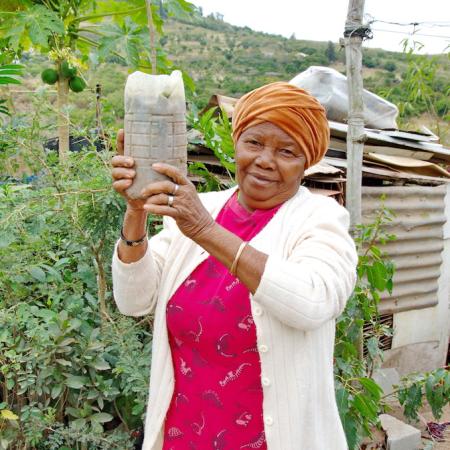
El Proyecto de Reforestación Comunitaria de Buffelsdraai, situado en la zona de amortiguación del vertedero regional de Buffelsdraai de Durban, se inició en noviembre de 2008. El objetivo inicial era compensar una parte de las emisiones de CO2 (declaradas como 307.208 toneladas equivalentes de CO2) asociadas a la celebración en la ciudad de varios partidos de fútbol de la Copa Mundial de la FIFA 2010TM. Sin embargo, aunque la mitigación del cambio climático era el objetivo inicial, el proyecto demostró rápidamente importantes beneficios para la adaptación al cambio climático, que ahora se consideran aún más importantes. En este contexto, la adaptación se refiere a las formas prácticas de gestionar los riesgos derivados de los efectos del clima, incluida la reducción de los riesgos a los que están expuestas las comunidades y el impulso de la economía local. La mejora de los servicios ecosistémicos prestados por los paisajes restaurados, por ejemplo la regulación del caudal de los ríos y el control de los sedimentos frente a lluvias e inundaciones erráticas, muestran beneficios directos para las comunidades locales. Entre los beneficios socioeconómicos concretos del proyecto de Buffelsdraai se encuentran el aumento de la seguridad alimentaria y de las oportunidades de subsistencia de los miembros de la comunidad local, así como la mejora de las opciones educativas de los escolares de la zona. Una de las muchas historias inspiradoras que han surgido desde el inicio del Programa de Reforestación de Durban es la de Melta Majola. Se inscribió como Tree-preneur en 2009 para empezar a cultivar árboles para el Proyecto de Reforestación de la Comunidad de Buffelsdraai. Melta vive con sus dos nietos y cuida de ellos tras la muerte de su hijo y su nuera. Gracias a este proyecto ha aprendido a recolectar semillas silvestres por su cuenta y ha cultivado muchos plantones para el proyecto de reforestación. La venta de árboles complementa el dinero que recibe de su pensión y le permite mantener mejor a su familia. Gracias al proyecto, ha podido comprar una estufa eléctrica, con lo que su casa es más segura, y también puede comprar alimentos con los créditos que recibe por los árboles. Esto le ha permitido liberar su pensión, que utiliza para pagar la escuela y el transporte de sus nietos. En una visita reciente al vivero casero de Melta, ésta tenía unas existencias de unos 1.200 árboles, valorados en unas 7.000 rupias. Melta ha indicado que aprecia el conocimiento de las plantas autóctonas que ha adquirido a través de este programa. Además, Melta participa en un proyecto de reciclaje de plásticos, latas y botellas en su zona, que también genera algunos ingresos.
